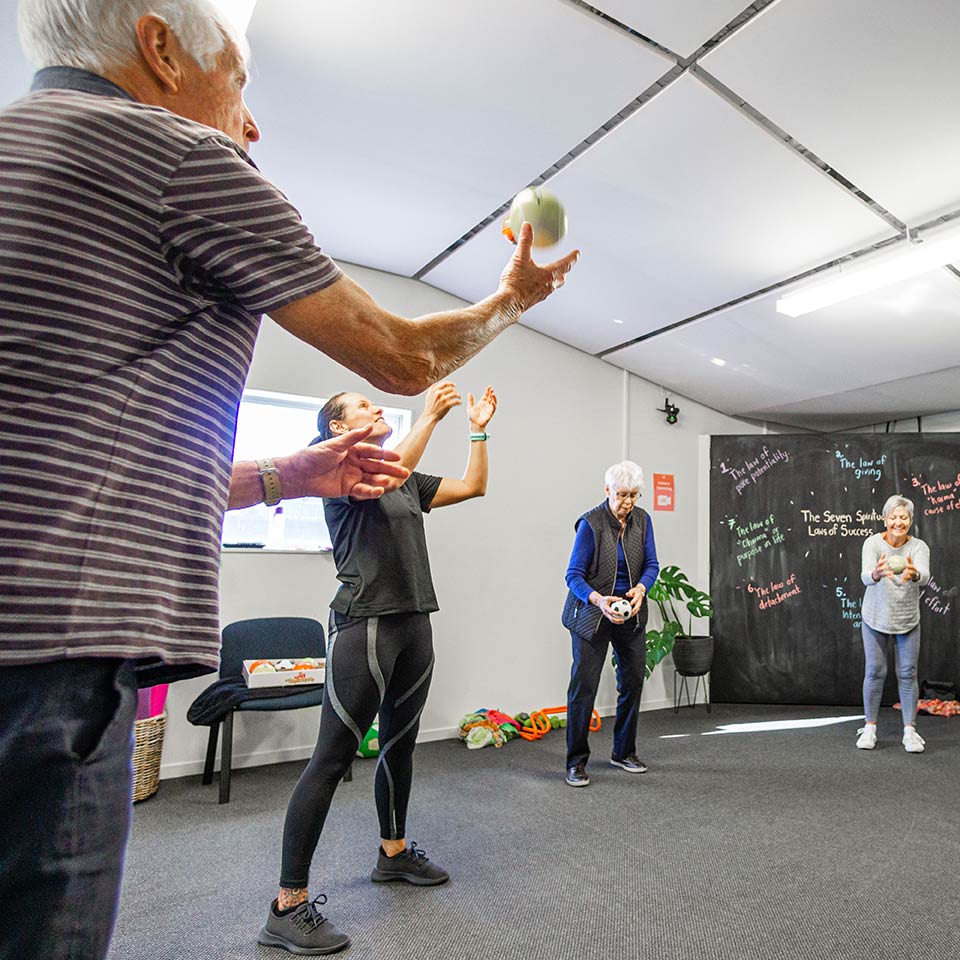
by Emma G | May 28, 2025 | Gym
As women, our bodies go through big changes as we reach our 40s and beyond. Hormones start to fluctuate, muscle mass begins to decline, and things we once did with ease can start to feel harder. You may feel more tired, less toned, or find it harder to manage your weight — even if your habits haven’t changed.
Here’s the truth: this stage of life requires a different approach to exercise. As Dr Stacy Sims famously says, “Women are not small men.” Our training needs shift with our hormones — and strength training becomes one of the most powerful tools we can use to support our changing bodies.
Why Strength Training Is Non-Negotiable After 40
Whether you’re peri-menopausal, menopausal, or post-menopausal, strength training helps you:
- Build and protect lean muscle
Muscle mass naturally declines with age — but resistance training helps you hold onto it (or even build it back). That means better shape, tone, and metabolic support.
- Support your bones and joints
Bone density decreases during menopause. Lifting weights provides the stimulus bones need to stay strong, reducing your risk of osteoporosis and fractures.
- Balance your hormones and mood
Resistance training helps regulate insulin, stress hormones and even sleep. It’s also one of the best natural ways to lift your mood and reduce anxiety.
- Improve body composition – not just weight
Many women find that traditional cardio doesn’t work the way it used to. Strength training shifts the focus from the scale to body composition — less fat, more function.
- Increase energy and independence
Everyday things like lifting shopping bags, going up stairs or getting off the floor feel easier when your body is strong. It’s not just about fitness — it’s about quality of life.
But I’ve Never Lifted Weights Before…
That’s ok. You don’t have to “go hard” or know your way around a gym. You just need a plan — and someone who understands what this stage of life feels like.
I offer 1-on-1 strength sessions for women 40+ that meet you where you’re at. We focus on proper form, gradual progression, and training that respects your energy, hormones, and lifestyle. Whether you’re managing menopause, chronic conditions, or just want to feel more in control of your body — I’m here to help.
Strong looks different on everyone. Let’s find what it means for you.
Book here!

by Emma G | May 23, 2025 | Parkinson's Disease
When most people think of Parkinson’s exercise, they picture physical training – movements to improve strength, balance, and coordination. And while that’s important, the real benefits often go far deeper.
As someone who works closely with the Parkinson’s community, I’ve seen how tailored, one-on-one movement support can impact not just the body, but also mood, confidence, and quality of life.
1. Movement Builds Confidence
My sessions are designed around you – your symptoms, your goals, and how you’re feeling on the day. We use proven techniques, including PD Warrior principles, boxing-based drills, and strength training to support neuroplasticity (your brain’s ability to adapt and form new connections).
It’s not all about pushing hard. It’s about staying consistent, challenged, and supported.
2. Support That Goes Beyond Exercise
Many clients say they feel more in control and less isolated after starting 1-on-1 support. We talk, we move, we adjust — and you get personalised care without needing to fit into a group setting.
That said, for those who want a social outlet, I also run regular walks and small gatherings through my Young Onset Parkinson’s community. It’s always optional.
3. Part of a Wider Team
If something arises that’s outside my scope — such as changes in voice, thinking or memory, or other concerns — I’ll connect you with trusted professionals. I work closely with local Parkinson’s educators, the nurse practitioner at the hospital, and other allied health providers to ensure your care is joined-up and considered.
Looking for personalised Parkinson’s support that fits your life and symptoms?
Let’s have a chat about how 1-on-1 movement training can help.
Call Emma on 027 431 5920

by Emma G | May 14, 2025 | Behaviour, Clients, Fitness, General Health, Movement
When the mornings are dark and the air’s chilly, it’s easy to lose your rhythm with exercise. Motivation dips, and suddenly it’s been weeks since your last walk, class, or stretch.
But here’s the truth — winter is when movement matters most.
Cold weather can make us feel sluggish, stiff and even lower our mood. Staying active helps combat those winter blues, supports immunity, and keeps our joints and muscles functioning well. And you don’t always need to push hard — consistency over perfection is the key.
Here are a few gentle reminders to help you reconnect with movement:
- Keep it simple. You don’t need an hour-long workout. A 15-minute stretch, walk or strength circuit still counts.
- Move at home. No commute, no cold wind – just you and a warm space. Try bodyweight strength, balance exercises or boxing moves.
- Buddy up. A friend, partner or trainer can help make movement feel less like a chore.
- Book it in. If it’s in your diary, you’re more likely to do it. Treat movement like any other appointment.
And if you’re still not sure where to start — that’s where I come in.
I offer in-home and personalised movement sessions tailored to your needs, energy and goals. Whether you’re rebuilding strength, managing a health condition or simply needing a bit of encouragement, I can help you find a routine that fits.
Ready to move again?
Book a free consult or get in touch to talk through what might suit you best.

by Emma G | Apr 29, 2025 | Parkinson's Disease
Check out my latest article for Parkinson’s New Zealand, I was recently featured in both their digital and printed newsletters. Here is the full article –
Making Movement a Daily Habit: Staying Motivated with Parkinson’s
Living with Parkinson’s presents challenges, but regular exercise is a powerful tool for managing symptoms and enhancing well-being. Evidence suggests that consistent exercise may help slow Parkinson’s progression.
However, staying motivated isn’t always easy, especially when dealing with fatigue, pain, stiffness, balance issues, or apathy—common symptoms that can make even the simplest tasks feel overwhelming. Acknowledging these barriers and working within your capabilities is the first step toward establishing a sustainable and empowering exercise routine.
The Power of Consistency
Exercise is as vital to daily life as eating well or getting enough sleep. The key isn’t perfection—it’s consistency. Even on low-energy days, small movements count. What matters most is the habit of starting. The duration or intensity can be adapted to how you’re feeling, but committing to some form of movement each day helps maintain momentum.
Exercise strengthens both body and mind. It’s not about being perfect; it’s about showing up for yourself every day, no matter how small the effort might seem.
Overcoming Common Obstacles to Keep You Moving
Living with Parkinson’s presents challenges, but staying active is possible with the right strategies. Rather than aiming for a perfect routine, focus on finding ways to move that work for you.
Fatigue: Energy levels can fluctuate, making it tough to stay consistent. Break movement into small, manageable chunks throughout the day. A brief stretch or short walk can be just as beneficial as a longer session when done regularly. Think little and often.
Stiffness: When movement feels difficult, begin with gentle stretches or range-of-motion exercises to ease into activity. Starting slow helps loosen tight muscles and prepares your body for more movement. Less movement leads to more stiffness, making it harder to get going again.
Balance Issues: Feeling unsteady can make exercise daunting. Incorporate movements while seated or use supportive surfaces, such as holding onto a countertop for stability. You can exercise from a seated position effectively if you are having a weaker lower body day or feeling unbalanced.
Apathy and Motivation: On low-energy days, simplify your approach by setting small, achievable goals, such as standing up every hour or stretching for five minutes. Celebrating these small wins can build momentum over time. If apathy is a challenge, creating a reminder list of daily tasks can help prompt action, even when motivation is low, encouraging movement and a sense of accomplishment.
Pain: Chronic pain can be a significant barrier to movement, but gentle, regular exercise can help ease discomfort over time. It’s important to focus on movements that feel manageable and supportive. Start by engaging in activities that encourage relaxation and mobility without increasing pain, such as slow stretching, mindful breathing exercises, or light walking. Incorporate pacing strategies—short sessions followed by rest—to help prevent overexertion. The goal is to keep moving within your personal limits, helping to build resilience and gradually reduce pain flare-ups.
Recognising these challenges and adapting your routine to fit your needs can make movement a positive and manageable part of daily life.
Building Motivation and Discipline
Motivation can be fleeting, but discipline will keep you moving forward. Establishing a routine is essential for making exercise a consistent part of your life. Here are some strategies to help stay on track:
- Choose What You Enjoy: Enjoyment makes it easier to stick with your routine. Explore different activities until you find something you enjoy and engage in.
- Make It Social: Join a class, exercise with a friend, or involve family members to make your sessions more enjoyable and engaging.
- Set Realistic Goals: Start small and build gradually. Celebrate small wins to stay motivated.
- Create a Routine: Set regular exercise times that fit into your schedule—just like brushing your teeth, it becomes second nature with time.
The Power of Exercise Snacks
Short bursts of movement, or “Exercise Snacks,” can be effective, providing boosts of energy and focus without overwhelming fatigue.
Incorporating visual reminders—such as sticky notes or setting alarms—can help keep movement at the forefront of your day. Plan your exercise sessions around your medication “on times” to ensure you’re moving when your body feels its best.
Embracing Empowerment Through Movement
Regular movement supports symptom management, improves balance, and enhances mood.
It’s important to listen to your body and be kind to yourself. There will be good days and challenging days—what matters is continuing to show up, no matter how small the effort.
Closing Thoughts: Movement with a Smile
I know it’s easy for me to say, and much harder for you to do—I see it firsthand working with the Parkinson’s community. Many people push themselves to do everything perfectly during classes, feeling anxious if they can’t. But here’s the thing: exercise isn’t about perfection. It’s about showing up, trying your best, and allowing yourself room for a little lightness.
The best approach? Embrace exercise with a bit of brevity—give yourself permission to be playful, have a laugh, and even be a little silly. Try not to judge what you can or can’t do—see each class as an opportunity to move in a way that works for you, meet some lovely people, and enjoy the experience. Movement doesn’t have to be serious to be effective. It’s about finding joy in the process and celebrating the effort, no matter how small.
Movement is a key part of living well with Parkinson’s, supporting physical function, mental clarity, and emotional resilience. Making movement a daily habit builds a foundation of strength, confidence, and determination to face each day.
Start where you are. Take one step at a time. Each movement counts, and every effort helps you feel stronger and more in control of your well-being.
If you need support or guidance in developing your exercise routine, feel free to reach out—I’m here to help you every step of the way.

by Emma G | Jan 22, 2025 | Behaviour, General Health
Putting yourself first is not selfish; it’s essential for your well-being and growth. You don’t need to do all of these steps, but integrating even a few into your life can make a meaningful difference.
Here’s a streamlined plan to help you make 2025 your healthiest year yet.
- Support Your Partner’s Healthy Choices by Joining Them
If your partner wants to change their diet or lifestyle, support them by participating. Shared goals foster accountability and success.
- Eat Mindfully
Slow down during meals, chew thoroughly, and ensure you swallow each bite before raising your fork again. This encourages proper digestion and helps you recognise fullness. Ask yourself if you need to finish everything on your plate each time.
- View Physical Activity as Hygiene
Think of exercise as you do brushing your teeth — a non-negotiable part of daily self-care. Find a form of exercise you enjoy.
- Hydrate First Thing in the Morning
Start your day with two glasses of water to rehydrate after sleep and energise your body.
- Make Decisions Based on How You Want to Feel
Your current feelings may not guide the best choices. Instead, align your actions with how you’d like to feel later.
- Optimise Meal Proportions
Build meals with a balanced 1:1 ratio of protein to carbohydrates. This can help stabilise energy and support your goals.
- Prioritise Sleep
Go to bed 20 minutes earlier each night. Across a week, this adds up to over two extra hours of restorative sleep.
- Prepare Meals in Advance
Set aside two hours each week for food preparation. Having goal-aligned meals ready removes decision fatigue and supports consistency.
- Experiment with New Recipes
Try a new recipe every couple of weeks. Expanding your palate and culinary skills can keep eating well enjoyable.
- Reframe Negative Feelings
Remember that “feeling yuk” is just a passing emotion. Moving your body or choosing a goal-aligned meal can shift this perspective quickly. The main goal being to feel good in yourself.
- Embrace Small Wins
A short, 10-minute workout is better than skipping exercise altogether. Consistency outweighs perfection.
- Enhance Sleep with Evening Carbs
If you’re struggling to sleep and follow a low-carb diet, add a small portion of starchy carbohydrates like kumara to your evening meal.
- Adjust Family Meals to Your Goals
Focus on tailoring your breakfast and lunch to your plan. For dinner, join the family’s routine. Progress isn’t about perfection; it’s about persistence and consistency.
- Stick to Long-Term Goals
Approach diet and exercise with a year-long perspective. Sustainable changes take time but deliver lasting results.
- Reconnect with Your Why Daily
Not everyone will support your journey, and that’s okay. Stay grounded in your reasons for change and revisit them regularly to stay motivated.
By incorporating these steps into your routine, you’ll create a solid foundation for lasting self-prioritisation and health throughout 2025.

by Emma G | Nov 20, 2024 | Behaviour
As we approach the end of the year, it’s common to feel drained. The holiday season, the demands of work, and the shifting seasons can all contribute to a sense of exhaustion. Despite feeling tired, it’s important to continue prioritising your health. Here are a few ways to maintain your daily health practices even when your energy feels low:
1. Simplify Your Routine
When you’re tired, complexity can be overwhelming. Stick to the basics—focus on the key practices that make the most difference, like staying hydrated, eating nutritious meals, and getting some form of movement. Simplify your workouts, opting for shorter but effective routines, or even a walk outdoors to keep your body moving.
2. Listen to Your Body
It’s crucial to acknowledge how your body feels. If you’re too exhausted for an intense workout, take a rest day. Consider yoga or stretching exercises to gently ease tension without overwhelming yourself. Your body needs time to recharge, so don’t feel guilty for taking a break when necessary.
3. Prioritise Sleep
Sleep is the foundation of all health. When you’re feeling tired, ensure you’re getting enough rest. Try to maintain a consistent sleep schedule and avoid late nights that can further drain your energy. Quality sleep will help replenish your energy levels and improve your overall well-being.
4. Stay Consistent, Not Perfect
Health practices don’t need to be perfect. If you’re tired, aim for consistency rather than intensity. A 20-minute session of mindful movement, a quick meditation, or even just taking a few minutes for deep breathing can be enough to support your health without overdoing it.
5. Nourish Yourself
End-of-year fatigue can be worsened by poor nutrition. Opt for whole, nutrient-dense foods to fuel your body. Include plenty of fruits, vegetables, lean proteins, and healthy fats. Staying hydrated and avoiding too much sugar, alcohol or caffeine will also help you maintain steady energy levels.
6. Get Outside
Fresh air and natural light can work wonders for combating fatigue. Even if it’s just a short walk outside, the exposure to sunlight and nature can help boost your mood and energy levels. This is also a great opportunity to practise mindfulness and connect with your surroundings.
7. Be Kind to Yourself
End-of-year fatigue doesn’t mean you’ve failed at your health practices. Remember, it’s okay to slow down and adjust your routine. Be compassionate toward yourself, and recognise that taking care of your mental and physical health during this time is just as important as when you’re feeling energetic.
Conclusion
While end-of-year tiredness is a natural part of the season, it doesn’t mean you have to completely abandon your health practices. By simplifying your routine, listening to your body, prioritising rest, and nourishing yourself, you can continue to nurture your health without overwhelming yourself. Remember, small, consistent efforts can have a big impact. Doing a little each day and maintaining that consistency, even when you’re tired, is the key to long-term health. It’s not about perfection, but about showing up for yourself every day, no matter how small the effort.
by Emma G | Sep 16, 2024 | Parkinson's Disease
For people grappling with Parkinson’s disease, the impact on vocal function is a common yet often overlooked aspect. Hypophonia, characterized by softer and less audible speech, can significantly affect communication. However, scientific research supports the efficacy of targeted voice exercises in mitigating these challenges and improving overall vocal health.
Studies such as the one conducted by Sapir et al. (2011) in the “Journal of Communication Disorders” highlight the effectiveness of voice exercises, particularly emphasizing the benefits of Lee Silverman Voice Treatment (LSVT®), a widely recognized program tailored for people with Parkinson’s. This program focuses on amplitude exercises, encouraging patients to produce louder and clearer speech, leading to increased vocal intensity and improved communication.
Another study by Ramig et al. (2014) published in the “Journal of Neurology, Neurosurgery & Psychiatry” delves into the neurophysiological aspects of voice exercises. The research suggests that targeted vocal exercises may induce neuroplastic changes in the brain, promoting neural adaptations that contribute to enhanced vocal control and articulation.
Incorporating scientific findings into practice, voice exercises for Parkinson’s encompass various techniques. Diaphragmatic breathing, as supported by studies such as that by Miller et al. (2007) in the “Journal of Speech, Language, and Hearing Research,” plays a crucial role in strengthening respiratory support for speech, resulting in improved vocal projection.
Beyond the physiological benefits, engaging in voice exercises has psychological implications. A study by Baker et al. (2011) in the “Journal of Medical Speech-Language Pathology” indicates that individuals who participated in regular voice exercises reported increased self-esteem and confidence in their communication abilities.
In conclusion, scientific evidence underscores the transformative impact of targeted voice exercises for Parkinson’s disease. By incorporating these practices into daily routines, patients can empower themselves to maintain vocal strength, clarity, and overall well-being, ultimately improving their communication skills and quality of life.

by Emma G | Mar 10, 2024 | Parkinson's Disease
Living with Parkinson’s disease presents unique challenges, but emerging research underscores the transformative impact of exercise on managing its symptoms. Beyond the physical benefits, regular physical activity has been proven to enhance overall well-being and quality of life for individuals grappling with Parkinson’s.
Exercise serves as a powerful ally in the battle against Parkinson’s, offering a range of benefits that extend far beyond the confines of a gym. One of the primary advantages is the positive impact on motor function. Rigorous workouts, including aerobic exercises, strength training, and flexibility routines, have been shown to improve balance, coordination, and overall mobility—common challenges for those with Parkinson’s.
Exercise has been linked to a reduction in the severity of non-motor symptoms, such as depression and anxiety, which often accompany Parkinson’s disease. The release of endorphins during physical activity acts as a natural mood booster, contributing to a more positive mental state.
Engaging in regular exercise may slow down the progression of Parkinson’s by promoting the release of neuroprotective factors. Studies suggest that physical activity stimulates the production of brain-derived neurotrophic factor (BDNF), a protein associated with the growth and survival of neurons. This neuroprotective effect is crucial for individuals with Parkinson’s, as it may help preserve brain function and delay the onset of more severe symptoms.
The significance of exercise in managing Parkinson’s disease cannot be overstated. By embracing a consistent and tailored exercise routine, individuals with Parkinson’s can empower themselves to take an active role in improving their physical and mental well-being, ultimately enhancing their overall quality of life.
I work 1-on-1 with clients with Parkinson’s Disease and currently have 4 x group classes a week for people with Parkinson’s. Please get in touch to discuss which option could work best for you.

by Emma G | Apr 14, 2021 | Behaviour, Business of Health, General Health, Movement
(more…)

by Emma G | Aug 12, 2020 | Behaviour
What is disordered eating?
Is it…?
- not eating breakfast
- having a cheat meal every week.
- fasting
- keto
- obsessing about macros
- binge and restriction cycles
We all choose different ways of eating and it’s a subject that brings up passion and conversation in people. A lot of us like to defend our choices and even preach about them. Eating, food types and behaviours is such an interesting topic, unlike smoking and other behaviours, it’s something we are unable to give up. There are so many posts, opinions, influencers, marketing ploys all attempting to push their way of eating, it can be a confusing mess trying to decipher it all.
Disordered eating can be used to describe unhealthy eating behaviours and concern about body image. It covers a range of irregular eating behaviours that may have not yet developed into a diagnosed eating disorder. People experiencing these behaviours maybe under a significant amount of physical, mental and emotional stress. This is a very serious issue and can progress into a diagnosed eating disorder.
How do you know if you have disordered eating behaviours?
I believe that most of us have some form of disordered eating from time to time, in varying levels and in different ways.
Physical and mental symptoms to look out for in yourself or loved ones
- Dieting
- Substantial weight fluctuations
- Rituals and routines with food and exercise
- Feelings of guilt around eating
- Preoccupation with food, weight, body composition, body image
- Loss of control around food
- Purging behaviours post eating
- Physical signs could be bad breath, dry skin, brittle hair, tooth decay
- Gut issues
- Amenorrhea, F.A.T (female athlete triad) / RED-S (relative energy deficiency in sport)
Having had, and still having a turbulent relationship with food, I would say that dieting is a disordered eating behaviour. Dieting can encourage the restrict and binge cycles. I ask my clients to try and find a way of eating for life, not for 8 or 12 weeks. If you are doing something you can’t maintain long term, then that’s a diet. Ask yourself, is your current way of eating serving you? Can you continue to adhere long term? How about instead thinking of permanent wee changes you can make to your eating behaviours for the long term?
Disordered eating is a serious issue, once behaviours become classified as an eating disorder, then we class the illness as psychological. Be aware that your disordered eating behaviours may jump in and out of various eating disorders even if you don’t exhibit the exact criteria for diagnosis.
Eating Disorders
- Bulimia nervosa – eating excessive amounts and purging in some way post eating
- Anorexia nervosa – restricting food intake
- Binge Eating Disorder (B.E.D) – excessive compulsive food consumption
- Avoidant Restrictive Food Intake Disorder (ARFID) – person avoids a certain type of food(s) completely
- Other specified feeding and eating disorder (OSFED) – behaviours overlap and jump in and out of the above
If the above is resonating with you in regard to yourself or others, then there are many tools to help.
Throughout my recovery I found that you need a team of people supporting you, encouraging you and nurturing you to help you through this, I believe you can’t do this alone.
If you would like some guidance with tools or where to start on your path to recovery, then please get in touch with me.
hello@emmagtotalhealth.co.nz
027 431 5920









